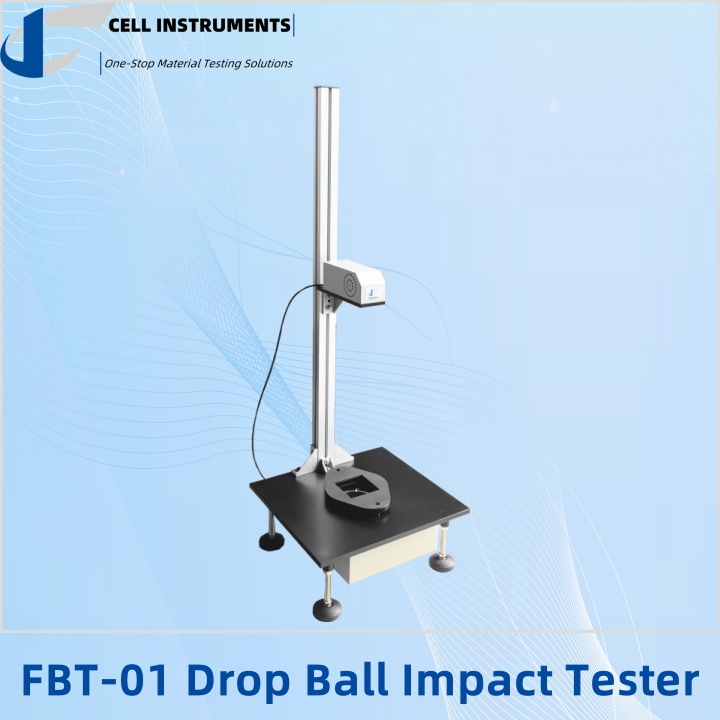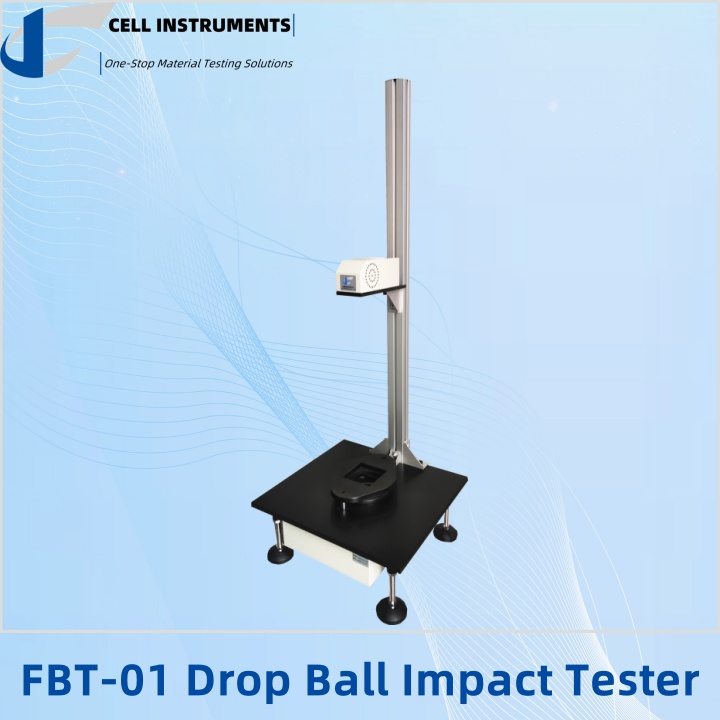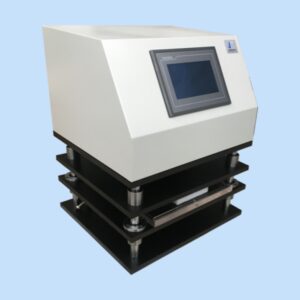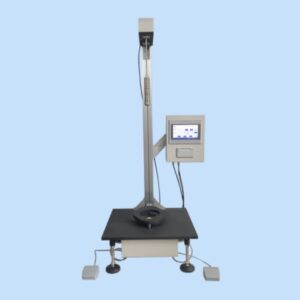FBT-01 Drop Ball Impact Tester
- Standard: ANSI Z87.1
- Manufacturer: Cell Instruments
- Applications: Plastic Materials, Safety Glasses, and more.
- Customization: Available for special testing requirements and automation transformations
Introduction of Drop Ball Impact Tester
A ball impact tester is a crucial instrument used to evaluate the impact resistance of various materials, including plastics, films, and protective eyewear. This testing method is widely adopted in industries such as packaging, medical devices, automotive, and safety equipment manufacturing to ensure materials can withstand sudden impact forces without cracking or deforming.
Falling Ball Impact Tester for Precise Impact Testing
The FBT-01 Falling Ball Impact Tester from Cell Instruments is a high-precision testing system designed for evaluating impact resistance in plastic films, sheets, foils, paper, and composite materials.
Key Features of FBT-01:
- PLC-controlled system with an intuitive HMI touchscreen interface.
- Adjustable impact height to simulate varying impact conditions.
- Electromagnetic suspension for precise ball release.
- Pneumatic sample clamping for secure and repeatable testing.
- Multiple ball size options for flexible testing applications.
- Built-in dot matrix printer for immediate test report generation.
- Optional advanced software for professional data analysis.
Main Technical Parameters:
| Parameter | Specification |
|---|---|
| Impact Height | 300mm-600mm (extendable) |
| Ball Diameters | 23, 25, 28.6, 38.1, 50.8 mm |
| Accuracy | 0.1g (0.1J) |
| Specimen Clamp | Pneumatic Clamp |
| Gas Supply | 0.6 MPa, Φ8 mm PU Pipe |
| Specimen Size | >150 mm x 150 mm |
| Power Supply | AC 110~220V, 50Hz |
Test Methods Overview
The Drop Ball Impact Tester uses a steel ball of known mass, which is released from a predetermined height to create a controlled impact on the test specimen. The material’s ability to resist damage—such as cracking, deformation, or rupture—is analyzed by observing the resulting effects.
The main variables in the test include:
- Drop Height: Adjustable between 300mm to 600mm (extendable based on requirements).
- Ball Size and Mass: Available in sizes like 23mm, 25mm, 28.6mm, and more.
- Impact Energy: The impact energy generated by the ball hitting the sample is analyzed to evaluate the material’s performance under shock loads.
The Importance of the Ball Dropping Test in Material Testing
The ball dropping test, a standard procedure in impact resistance evaluation, measures how materials respond to the sudden force of a falling steel ball. This test is particularly essential for safety applications, such as protective eyewear, to comply with ANSI Z87.1 standards.
How the Ball Dropping Test Works
- A steel ball of known weight and diameter is released from a predefined height.
- The ball impacts the test specimen, simulating real-world impact conditions.
- Observations are made on deformation, cracking, or penetration to assess the material’s impact resistance.
- Test results help determine whether the material meets industry safety and durability standards.
ANSI Z87.1 Compliance: Key Testing Standards for Eye Protection
ANSI Z87.1 specifies rigorous impact resistance requirements for protective eyewear. One of the primary methods to assess compliance is the 9.6 Drop Ball Test, which includes:
- Apparatus: A rigidly mounted headform with a 30 kg base, ensuring stability.
- Test Procedure: A 25.4 mm (1.0 in.) diameter steel ball, weighing 68 g (2.4 oz.), is dropped from 127 cm (50 in.) onto the lens.
- Assessment Criteria: If the eyewear withstands the impact without fracture or penetration, it passes the test.
Factors Influencing Impact Test Results
Several variables affect the outcome of a ball impact test, including:
- Drop Height: The greater the height, the stronger the impact force.
- Ball Mass and Diameter: Heavier and larger balls exert higher impact forces.
- Material Properties: Hardness, flexibility, and composition influence impact resistance.
- Clamping Method: Securely clamping the specimen ensures accurate results.
Applications of the Drop Ball Impact Tester
The Drop Ball Impact Tester is widely used across industries to ensure material quality and durability:
- Packaging: Testing film and plastic sheets for packaging to ensure they can withstand rough handling during transport.
- Medical Devices: Assessing the toughness of medical packaging materials.
- Pharmaceuticals: Evaluating packaging that protects sensitive pharmaceutical products.
- Textiles and Paper: Determining the impact strength of paper and thin textiles.
- Daily Chemicals: Testing materials used in personal care product containers and packaging.
Why Choose the FBT-01 Ball Impact Tester from Cell Instruments?
- High accuracy and repeatability for reliable results.
- User-friendly operation with automated test processes.
- Compliance with international standards such as ANSI Z87.1.
- Versatile applications in plastics, films, composites, and protective materials.
FAQ
What is the importance of impact resistance testing?
Impact resistance testing helps ensure that materials can withstand sudden forces, reducing the risk of product failure in the field.How does the ball dropping test simulate real-world impact conditions?
By dropping a steel ball from a specific height, the test replicates sudden impact forces that materials might encounter in practical applications.What are the key requirements of ANSI Z87.1’s drop ball test?
The test involves dropping a 25.4 mm steel ball from 127 cm onto protective eyewear lenses to assess their impact resistance.Can the test height and ball size be adjusted?
Yes, both the drop height and ball size/mass can be customized to meet specific testing requirements.How is the test data recorded and analyzed?
Test results are displayed in various units and can be further analyzed using optional professional software for in-depth reporting.
By using the FBT-01 Falling Ball Impact Tester, manufacturers can ensure that their materials meet industry safety standards, reducing failure risks and improving product durability.
Relative Models
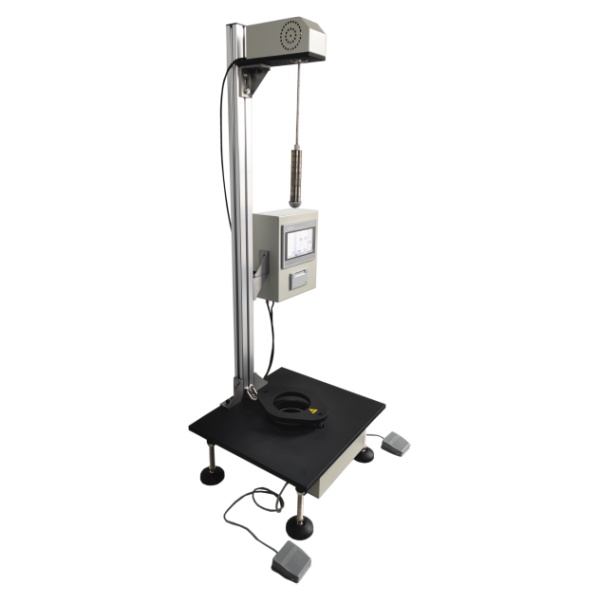
FDT-01 Dart Impact Tester
Measure the impact resistance of plastic films
ASTM D1709, ISO 7765-1, JIS K7124-1, GB/T 9639.1


